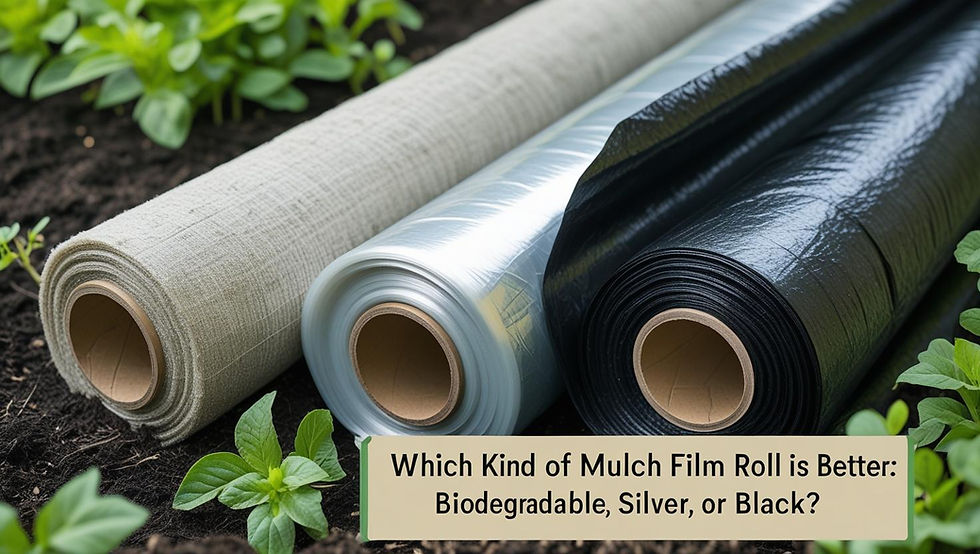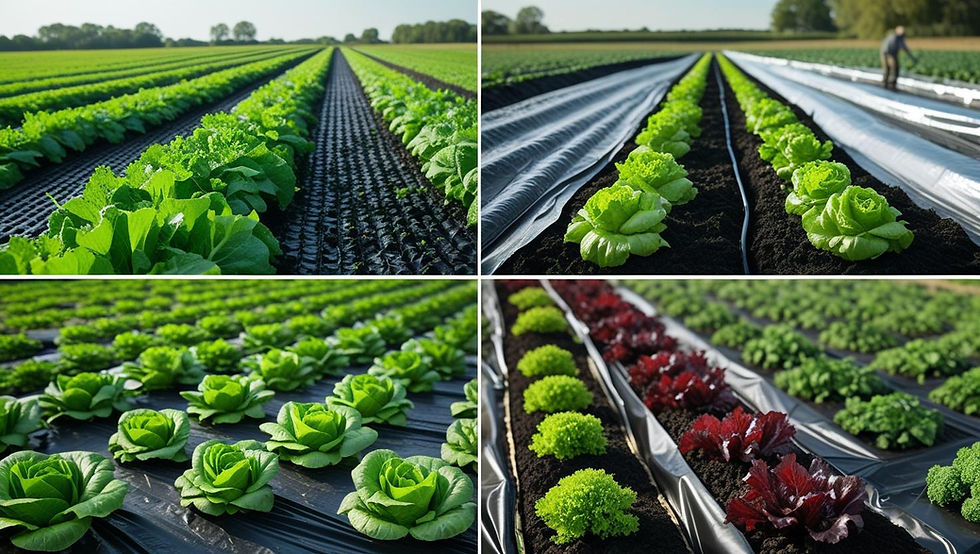Which Kind of Mulch Film Roll Is Better Biodegradable, Silver, or Black?
- Rahul Solanki
- 25 minutes ago
- 4 min read

Introduction
In modern agriculture, the choice of mulch film roll can have a major impact on long-term sustainability, crop productivity, and soil health. Farmers frequently argue over whether biodegradable, silver, or black film rolls produce the best results. Depending on the crop type, climate, and farming objectives, each option has a unique set of benefits and factors to consider. Biodegradable mulch films support sustainable farming methods, silver mulch films improve light reflection and discourage pests, and black mulch films are popular for their weed-control properties. Farmers can choose the best option for their fields by being aware of each one's advantages and disadvantages.
What is a Mulch Film Roll?
A roll of mulch film is a continuous sheet of material, typically made of plastic or biodegradable, that is applied to agricultural soil. It offers a barrier that protects crops, inhibits weed growth, preserves soil moisture, and helps control temperature. Mulch films are frequently utilised in horticulture, fruit farming, and vegetable cultivation.
Common Purposes
Conserves water by reducing soil evaporation.
Prevents weed growth by blocking sunlight.
Enhances soil temperature for better germination.
Improves crop quality by preventing soil-to-fruit contact.
Reduces the need for herbicides and weeding labor.
Types of Mulch Film Rolls
1. Black Mulch Film Roll
Features:
Opaque and widely used in various crops.
Blocks sunlight from reaching the soil, preventing weeds from germinating.
Benefits:
Strong weed suppression.
Retains soil moisture effectively.
Affordable and easily available.
Considerations:
Can cause soil overheating in hot climates.
Disposal can lead to plastic waste.
2. Silver Mulch Film Roll
Features:
Reflective surface that deters insects.
Enhances light availability to crops.
Benefits:
Natural pest control without excessive pesticide use.
Maintains cooler soil in hot conditions.
Improves crop quality and appearance.
Considerations:
Higher cost compared to black mulch films.
Requires proper installation to maximize benefits.
3. Biodegradable Mulch Film Roll
Features:
Made from renewable or compostable materials.
Designed to decompose naturally in soil after its useful life.
Benefits:
Environmentally sustainable and eco-friendly.
Reduces labor costs since no removal is needed.
Improves soil fertility as it decomposes.
Considerations:
More expensive upfront compared to polyethylene films.
Decomposition rates vary depending on soil conditions and climate.
Comparison: Which Mulch Film Roll is Better?
Weed Control
Black Film: Excellent weed suppression.
Silver Film: Moderate weed control but more focused on pest deterrence.
Biodegradable Film: Provides good weed control but depends on thickness and material.
Pest Management
Black Film: Does not repel insects.
Silver Film: Reflective surface naturally repels pests like aphids and whiteflies.
Biodegradable Film: Similar to black films in pest management; may be combined with other pest control measures.
Soil Temperature Regulation
Black Film: Warms soil quickly but may overheat in hot climates.
Silver Film: Keeps soil cooler during summer.
Biodegradable Film: Performance varies, often similar to black film but eco-friendly.
Environmental Impact
Black Film: Contributes to plastic waste unless recycled.
Silver Film: Same issue with disposal.
Biodegradable Film: Decomposes naturally, leaving no harmful residues.
Cost Factor
Black Film: Most affordable.
Silver Film: Moderately expensive.
Biodegradable Film: Highest upfront cost but saves removal and disposal costs.
How to Choose the Right Mulch Film Roll
Crop Type: Leafy vegetables may benefit from silver films, while root crops may thrive with black films.
Climate: Hotter climates may favor silver films to prevent soil overheating, while cooler areas benefit from black films.
Sustainability Goals: Farmers aiming for eco-friendly farming should prioritize biodegradable mulch film rolls.
Budget: Black films are cost-effective, but biodegradable films offer long-term savings.
Practical Tips for Using Mulch Film Rolls
Proper Installation: Ensure the film is stretched tightly to avoid damage.
Anchor Edges: Use soil, stones, or clips to prevent wind lifting.
Combine with Drip Irrigation: Provides water directly to plant roots for maximum efficiency.
Monitor Regularly: Check for damage, pests, or signs of decomposition.
Match to Crop Needs: Select film color and type based on crop and local conditions.
FAQs
Which mulch film roll lasts longer in the field?
Black and silver mulch films usually last an entire growing season, while biodegradable films decompose naturally, depending on soil and weather conditions.
Does silver mulch film really repel pests?
Yes, silver mulch films reflect sunlight, which confuses and repels pests such as aphids, thrips, and whiteflies, reducing the need for chemical pesticides.
Can biodegradable agricultural mulch film replace traditional plastic?
Yes, biodegradable agricultural mulch film is an effective alternative. It offers the same moisture retention and weed control benefits as plastic films while eliminating the problem of plastic waste.
Which mulch film roll is best for water conservation?
All types help retain soil moisture, but black and biodegradable films are especially effective in reducing evaporation.
Is the higher cost of biodegradable mulch film justified?
Yes, although more expensive initially, biodegradable films save costs on labor, removal, and disposal, while supporting eco-friendly farming practices.
Conclusion
The specific objectives, climate, and financial constraints of a farmer determine whether to use biodegradable, silver, or black mulch film rolls. Silver mulch films are excellent at controlling pests and keeping the soil cooler, black mulch films are still popular because they are inexpensive and suppress weeds, and biodegradable mulch films are the most environmentally friendly option for farming.
Biodegradable options offer unparalleled benefits for long-term soil health and environmentally friendly practices. Silver and black films are still valuable, though, for short-term cost-effectiveness. Farmers can improve crop yield, save resources, and support sustainable agricultural practices by knowing the advantages of each option.
For More Information Visit: Tilak Poly pack Pvt.Ltd



Comments